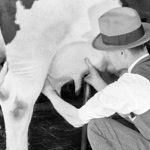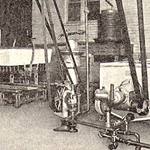Prevention
Over the years many efforts have been made to stop the spread of tuberculosis. From legislation banning spitting in public, to the development of vaccinations, to public screening programs, preventative efforts have sought to inform people about the disease and to stop the spread of the disease.
Pasteurization and Dairy Controls
For centuries before the introduction of the pasteurization of milk, bovine tuberculosis presented a huge threat to children and youth between the ages of 5 and 15 who were infected through milk and meat products. In 1900 approximately 15% of tuberculosis cases were caused by dairy products. Many public health experts and scientists were focused on finding ways to reduce such infections in children prior to the First World War.
Pasteurizing milk products, or heating the milk to kill any bacteria within it, became a common process in many urban areas in the twentieth century. For example, in Toronto an ordinance requiring pasteurization was passed in 1918. Dairy farmers resisted the implementation of widespread pasteurization, though, and the process did not become compulsory in Ontario until 1938, the first province to pass such a law. Even then, however, pasteurization was only required in urban municipalities; the law was extended to rural areas by 1941.
While efforts to impose compulsory pasteurization were underway, health officials and farmers also undertook to eliminate infected cattle from herds. The development of the tuberculin test after 1890 provided a reliable method of testing. Farmers submitted their herds to voluntary testing beginning around 1900, but the farmers did not receive any compensation for the infected cattle they culled. This changed in 1914 when the Department of Agriculture formalized a compensation policy, making it more appealing for farmers to voluntarily test their herds. In 1919 the federal government created a system of herd accreditation that formally indicated that herds were not contaminated with tuberculosis. Only milk from accredited herds could be sold. The proportion of infected cattle in Canada decreased from 5% in the 1920s to 2% by 1950.
Today pasteurization regulations are enforced by the federal government.
Explore the picture gallery to learn more about this preventative measure.




